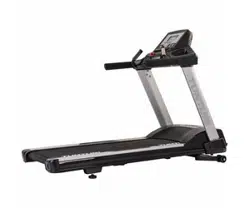Loading ...
Loading ...
Loading ...

32
English
maintenance as outlined within the Owner’s Manual
for the product. Furthermore, the warranty does not
cover defects arising from usage and storage within
an unsuitable environment as described within the
Owner’s Manual which should be indoors, dry, dust
and grit free and within a temperature range of +15°C
to +35°C. The warranty does not cover maintenance
activities, such as cleaning, lubricating, and normal part
adjustments, nor installation
procedures that customers can accomplish themselves,
such as changing uncomplicated meters, pedals and
other similar parts not requiring any dismantling/
reassembling of the fitness equipment. Warranty
repairs carried out by other than authorised Tunturi
representatives are not covered.
Failure to follow the instructions given in the Owner’s
Manual will invalidate the product’s warranty.
Cleaning and maintenance
WARNING
• Before cleaning and maintenance, remove the
mains plug from the wall socket.
• Do not use solvents to clean the equipment.
- Do not block the ventilation openings. Keep the
ventilation openings clear from dust, dirt and other
obstructions.
- Clean the equipment with a soft, absorbent cloth
after each use.
- Clean the visible parts of the equipment with a
vacuum cleaner with a small suction nozzle
- Regularly check that all screws and nuts are tight.
Belt and Running Deck
Your treadmill uses a very high-efficient low-friction
bed. Performance is maximized when the running deck
is kept as clean as possible. Use a soft, damp cloth or
paper towel to wipe the edge of the belt and the area
between the belt edge and frame. Also reach as far as
practical directly under the belt edge. This should be
done once a month to extend belt and running deck
life. Use water only - no cleaners or abrasives. A mild
soap and water solution along with a nylon scrub brush
will clean the top of the textured belt. Allow the belt to
dry before using.
WARNING
• The Running belt is pre-waxed. Any form
lubrication will harm the performance and
durability of the running belt.
Belt Dust
This occurs during normal break-in or until the belt
stabilizes. Wiping excess off with a damp cloth will
minimize build-up.
General Cleaning
Dirt, dust, and pet hair can block air inlets and
accumulate on the running belt. On a monthly basis:
vacuum underneath your treadmill to prevent buildup.
Twice a year, you should remove the black motor hood
and vacuum out dirt that may accumulate.
UNPLUG POWER CORD BEFORE THIS TASK.
Belt adjustments (Fig. E-60)
Adjustment must be made from the rear roller. The
adjustment bolts are located at the end of the step rails
in the end caps.
- Tighten the rear roller bolts (clockwise) only enough
to prevent slippage at the front roller. Turn both
running belt tension adjustment bolts in increments
of 1/4 turn each and inspect for proper tension by
walking on the belt at a low speed, making sure the
belt does not slip. Keep tensioning the bolts until
the belt stops slipping.
- If you feel the belt is tight enough, but it still slips,
the problem may be a loose Motor drive belt under
the front cover.
- Do Not Over-tighten
Over tightening will cause belt damage and
premature bearing failure.
Running belt tracking adjustment
The performance of your treadmill is dependent on
the frame running on a reasonably level surface. If
the frame is not level, the front and back roller cannot
run parallel, and constant belt adjustment may be
necessary.
The treadmill is designed to keep the running belt
reasonably centered while in use. It is normal for some
belts to drift near one side while the belt is running with
no one on it. After a few minutes of use, the running
belt should have a tendency to center itself. If, during
use, the belt continues to move toward one side,
adjustments are necessary.
Exception:
During rehabilitation where the user is using one leg
much stronger than the other, it might happen that
the running belt drifts to one side. In these cases you
should not adjust unless the running belt does not
centre itself during normal condition usage.
To set running belt tracking (Fig. E-59)
A 10 mm Allen wrench is provided to adjust the rear
roller. Make tracking adjustments from the left side only.
Set belt speed at approximately 3 to 5 kph.
Remember, a small adjustment can make a dramatic
difference!
Loading ...
Loading ...
Loading ...
